 Regular readers of the WineCompass Blog will recognize the abundant number of posts regarding González Byass, the Jerez producers of Tio Pepe - a fino style of Sherry that the winery has created and exported since its founding in 1844. The winery is still owned and operated by the relatives of founder Manuel Maria González and over time has incorporated other wine brands representing diverse Spanish wine regions. But sherry is still their core product with over a dozen labels joining the famed uncle Jose Angel (Tio Pepe).
Regular readers of the WineCompass Blog will recognize the abundant number of posts regarding González Byass, the Jerez producers of Tio Pepe - a fino style of Sherry that the winery has created and exported since its founding in 1844. The winery is still owned and operated by the relatives of founder Manuel Maria González and over time has incorporated other wine brands representing diverse Spanish wine regions. But sherry is still their core product with over a dozen labels joining the famed uncle Jose Angel (Tio Pepe). 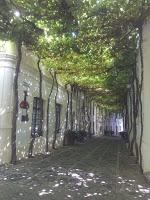 During a family trip to Seville, mutual contacts were able to schedule a private tour and tasting of the facility - still located within Jerez de la Frontera and an hour and change train ride away. The actual production is now conducted outside the city center, but the original Tio Pepe winery operated largely in the center adjacent to the Cathedral and Alcazar. This facility now hosts a tasting and event center, administrative offices, distillery, and barrelhouse. Lots of barrels stacked together based on several solera systems. Stone streets are covered by grape canopies creating a semblance of Tio Pepe as a town upon itself.
During a family trip to Seville, mutual contacts were able to schedule a private tour and tasting of the facility - still located within Jerez de la Frontera and an hour and change train ride away. The actual production is now conducted outside the city center, but the original Tio Pepe winery operated largely in the center adjacent to the Cathedral and Alcazar. This facility now hosts a tasting and event center, administrative offices, distillery, and barrelhouse. Lots of barrels stacked together based on several solera systems. Stone streets are covered by grape canopies creating a semblance of Tio Pepe as a town upon itself. 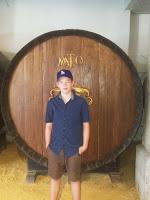 The staff was very gracious, taking time to accommodate our visit and providing a thorough and educational journey through ten sherry wines. Melanie, our tour guide, explained the history, topography, winemaking, and aging process while Neil provided an in-depth dissertation on each sherry and its origin. Their talents made the visit enjoyable and eye-opening to each of us - the wine geek, skeptic, and roguish and inappropriate teenager. Cheers to Tio Pepe, González Byass, their staff, and everyone who made the trip possible.
The staff was very gracious, taking time to accommodate our visit and providing a thorough and educational journey through ten sherry wines. Melanie, our tour guide, explained the history, topography, winemaking, and aging process while Neil provided an in-depth dissertation on each sherry and its origin. Their talents made the visit enjoyable and eye-opening to each of us - the wine geek, skeptic, and roguish and inappropriate teenager. Cheers to Tio Pepe, González Byass, their staff, and everyone who made the trip possible. 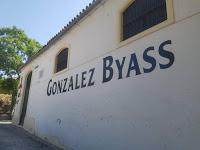 The Background
The BackgroundEven though the Jerez Regulatory Council stipulates that 60% of the grapes must come from Jerez Superior in order to be labeled Jerez Sherry, González Byass uses 100% grapes cultivated in the declared Jerez Superior area. The vineyards in Jerez are composed of a white soil called Albariza that consists of 60% chalk - which retains moisture that is critical during the region's long hot and dry summers.
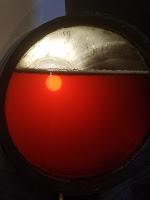
Tio Pepe Flor
The grapes are Palomino and Pedro Ximenez (PX) and they are handled quite differently. The Palomino grapes are generally hand-harvested then sent directly to the press. On the other hand, the PX grapes are harvested later in the season and then sundried in a process called "soleo". The bunches are laid out on straw mats for up to two weeks where 40-50% of their volume evaporates. This is a labor-intensive process since the grapes must be covered in plastic at night, then uncovered and flipped each morning as a precaution from the morning dew. However, the reward is grapes with highly concentrated sugars -- ideal for the winery's sweet sherries.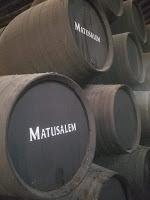
All sherries are aged following the traditional Solera system where the wines are blended in 600-litre American oak casks and then moved through the system as wine is taken from the bottom casks. Many styles are produced with distinctive characters depending on whether they have been aged under the influence of the flor (a layer of natural yeast) or as an oloroso (in contact with oxygen). Here are the wines we tasted.
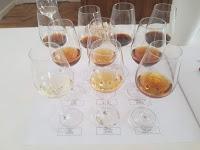
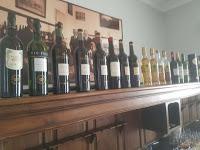
Tio Pepe Fino Palomino (15% abv)
This Fino (dry) style sherry is based on the free run and light first press of Palomino in order to obtain the juice most capable of creating an elegant wine. After the wine is fermented to 11-12% abv it is fortified to 15.5% abv and stored in American oak casks, leaving the top 100 liters empty. This allows the development of the flor, a unique layer of yeast produced naturally in Jerez. This layer protects the wine from oxygen and after four years of age, provides the wine with its unique aroma and character. This aroma actually resembles muscadine, whereas the core is green apples and almonds.
Viña AB Amontillado Palomino (16.5% abv)
The wine starts with a Tio Pepe base after the standard four years in the Tio Pepe solera system. The wine is then transferred to the Vina AB Solera where it remains for an additional eight years - basically a 12 year Tio Pepe. This longer aging extracts elements from the American Oak such as caramel and vanilla. The wine also features the essence of dried fruits and nuts while staying relatively dry.
Del Duque Amontillado VORS Palomino (21.5% abv)
This wine follows a similar process by taking 10-year-old wine from the Amontillado Viña AB Solera and transferring it to the Del Duque Solera where it is aged an additional 20 years making this a VORS = or very old sherry. The 30 years has condensed the wine, increased the abv, and expanded the mouthfeel and oak elements. An excellent sherry.
Alfonso Oloroso Palomino (18% abv)
The must for this wine comes from the second press which normally provides more structure and tannins (seeds, skins, and stems). After the wine is fermented to 11-12% abv, it is fortified to 18% and like the Tio Pepe housed in American Oak with an empty top layer of 100 liters. However, the flor does not develop because the yeast can not survive past 16% abv. The wine undergoes complete oxidization while extracting elements from eight years in the barrel. Complex and spicy, nuts and vanilla.
Leonor Palo Cortado Palomino (20% abv)
The wine is created like the Alfonso except it is made from the highest quality free-run juice (like the Tio Pepe) and spends 12 years in the Leonor Solera system. This is a unique, new style with a nutty aroma leading to a toasted cream palate.
Apóstoles VORS Medium Palomino/PX (20% abv)
This is an 87-13 blend where the Palomino comes from the Leonor Solera system. The PX grapes are firmly pressed (think of olive oil production) and the must ferments to 7% abv. After fortification to 15% abv, the wine enters the Pedro Ximenez Solera system where it ages for 12 years like the Leonor Solera. The wine is then blended and added to the Apostoles Solera where it ages an additional 18 years. The wine has a tremendous mouthfeel with dried fruits and caramel.
Solera 1847 Cream Palomino/PX (18% abv)
This 75-25 blend is derived from the first press of the continuous Palomino press in order to obtain a little more structure and tannic body. Following fermentation to 11-12%, the wine is fortified to 18% and enters the Oloroso Solera where complete oxidization occurs because of the empty 100 liters. The Pedro Ximenez wine comes from the Pedro Ximenez Solera system. Both wines are pulled from their respective solera systems after four years are blended and then aged an additional four years together in the 1847 Solera system. The wine picks up more fig and dried fruit characters with some caramel and vanilla - simply delicious.
Matusalem VORS Cream Palomino/PX (20.5% abv)
The Palomino and Pedro Ximenez wine in this blend comes from the Olorosa Solera and Pedro Ximenez Solera systems described above. However, the wines remain in their respective solera systems for 15 years before being pulled, blended, and aged an additional 15 years in the Matusalem Solera system. The wine comes across drier than the Solera 1847 with a bittersweet flavor of spices, raisins, and dried fruit.
Nectar Pedro Ximenez (15% abv)
The sherry comes from the Nectar Solera system where the PX grapes were fermented to 7% and then fortified to 15%. After eight years of aging, this wine is full of fig flavors with enough acidity to help balance the sweetness. A family favorite.
Noé VORS Pedro Ximenez (15.5% abv)
For this sherry, the PX grapes were fermented and fortified as the Nectar, but the must enters the Noé Solera system for 30 years. This results in a complex and textured wine, sweet figs but nice acidity.
